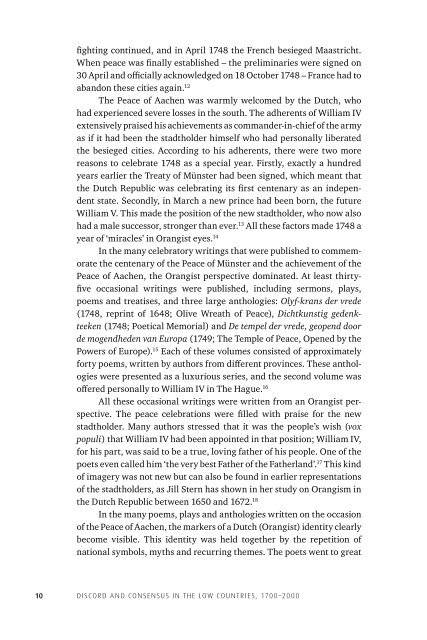Discord Consensus
7aze300jFJo
7aze300jFJo
Create successful ePaper yourself
Turn your PDF publications into a flip-book with our unique Google optimized e-Paper software.
fighting continued, and in April 1748 the French besieged Maastricht.<br />
When peace was finally established –the preliminaries were signed on<br />
30 April and officially acknowledged on 18 October 1748 – France had to<br />
abandon these cities again. 12<br />
The Peace of Aachen was warmly welcomed by the Dutch, who<br />
had experienced severe losses in the south. The adherents of William IV<br />
extensively praised his achievements as commander-in-chief of the army<br />
as if it had been the stadtholder himself who had personally liberated<br />
the besieged cities. According to his adherents, there were two more<br />
reasons to celebrate 1748 as a special year. Firstly, exactly a hundred<br />
years earlier the Treaty of Münster had been signed, which meant that<br />
the Dutch Republic was celebrating its first centenary as an independent<br />
state. Secondly, in March a new prince had been born, the future<br />
William V. This made the position of the new stadtholder, who now also<br />
had a male successor, stronger than ever. 13 All these factors made 1748 a<br />
year of ‘miracles’ in Orangist eyes. 14<br />
In the many celebratory writings that were published to commemorate<br />
the centenary of the Peace of Münster and the achievement of the<br />
Peace of Aachen, the Orangist perspective dominated. At least thirty-<br />
five occasional writings were published, including sermons, plays,<br />
poems and treatises, and three large anthologies: Olyf-krans der vrede<br />
(1748, reprint of 1648; Olive Wreath of Peace), Dichtkunstig gedenkteeken<br />
(1748; Poetical Memorial) and De tempel der vrede, geopend door<br />
de mogendheden van Europa (1749; The Temple of Peace, Opened by the<br />
Powers of Europe). 15 Each of these volumes consisted of approximately<br />
forty poems, written by authors from different provinces. These anthologies<br />
were presented as a luxurious series, and the second volume was<br />
offered personally to William IV in The Hague. 16<br />
All these occasional writings were written from an Orangist perspective.<br />
The peace celebrations were filled with praise for the new<br />
stadtholder. Many authors stressed that it was the people’s wish (vox<br />
populi) that William IV had been appointed in that position; William IV,<br />
for his part, was said to be a true, loving father of his people. One of the<br />
poets even called him ‘the very best Father of the Fatherland’. 17 This kind<br />
of imagery was not new but can also be found in earlier representations<br />
of the stadtholders, as Jill Stern has shown in her study on Orangism in<br />
the Dutch Republic between 1650 and 1672. 18<br />
In the many poems, plays and anthologies written on the occasion<br />
of the Peace of Aachen, the markers of a Dutch (Orangist) identity clearly<br />
become visible. This identity was held together by the repetition of<br />
national symbols, myths and recurring themes. The poets went to great<br />
10<br />
DISCORD AND CONSENSUS IN THE LOW COUNTRIES, 1700–2000


